Rabbit & Bear

From Sorry! by Norbert Landa, ill. by Tim Warnes (Little Tiger Press 2005) | Illustration © 2005 by Tim Warnes
I’ve written before about the plethora of bears and rabbits and mice (and moles!) in kid’s books. Publishers can’t seem to get enough of them.
For example, my book, Sorry! written by Norbert Landa (Little Tiger Press 2009). I’m still pleased with my art (and I really like the quirky tone of Landa’s writing).
Bear and Rabbit were the best friends you can imagine.
They lived in their Bear-Rabbit house.
They cooked their Bear-Rabbit meals in their Bear-Rabbit kitchen.
Rabbit was better at frying mushrooms.
Bear was perfect at making honey-cakes.
Here they are sharing a story in their treehouse. (Note the Miffy reference!)
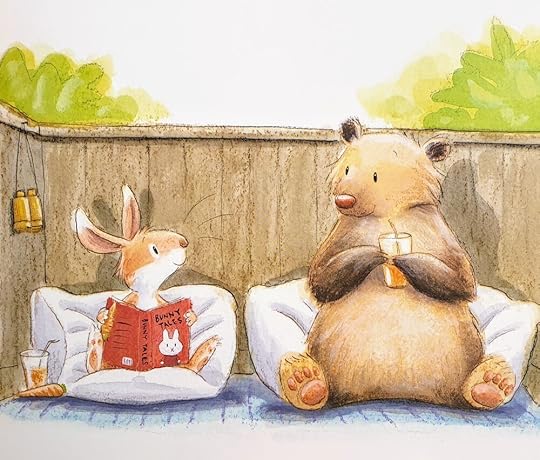
From Sorry! by Norbert Landa, ill. by Tim Warnes (Little Tiger Press 2005) | Illustration © 2005 by Tim Warnes
Sorry! is firmly in classic picture book territory: predictably, the best friends squabble and fall-out. Each realises the error of their ways, seek reconciliation, and the conflict is resolved. All’s well that ends well. (No surprises there, then!)
So if it’s a satisfying, gently moral tale with quality illustrations that you’re after - then look no further.
If, however, you fancy something rather more anarchic, expressive and funny, then please - step this way…
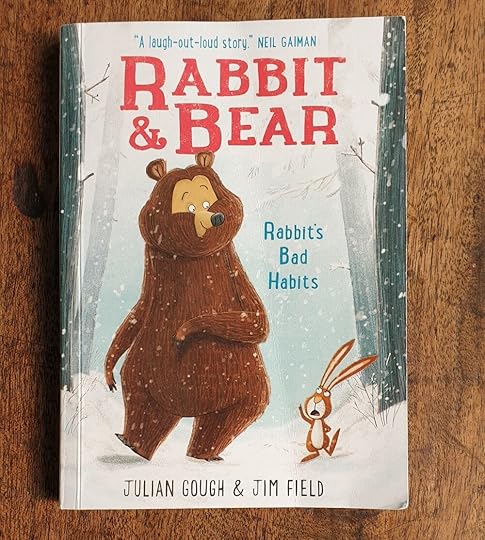
Rabbit & Bear: Rabbit’s Bad Habits by Julian Gough, ill. by Jim Field (Hodder 2016) | Illustration © 2016 by Jim Field
My Good to Read recommendation this week is the first in the Rabbit & Bear series from Julian Gough and Jim Field: Rabbit & Bear: Rabbit’s Bad Habits (Hodder 2016).
Now, whereas my rabbit in Sorry! loses his temper and strides back home to slam the door, this rabbit notches up the tension somewhat.
He’s one bumptious bunny, to be sure.
“Now if you could do me a favour…”
“I’d be delighted,” said Bear.
Rabbit nodded. “Go away,” he said…
‘I love trying to capture the fantastic humor of Rabbit’s character with his furious frown, or stomping his feet, or whether he is leaping in the air in his overly melodramatic way,’ says illustrator Field. ‘It cracks me up drawing him.’
And he does an AMAZING job, with stylish turquoise and grey toned illustrations.
In contrast to the supercilious Rabbit, Bear is gentle, patient and naive.
“My Grandfather was buried in an Avalanche [,” said Rabbit.]
“He had to eat his own leg to survive, while he was waiting for them to dig him out.”
“Really?” said Bear, impressed. “He must have been buried for a very long time.”
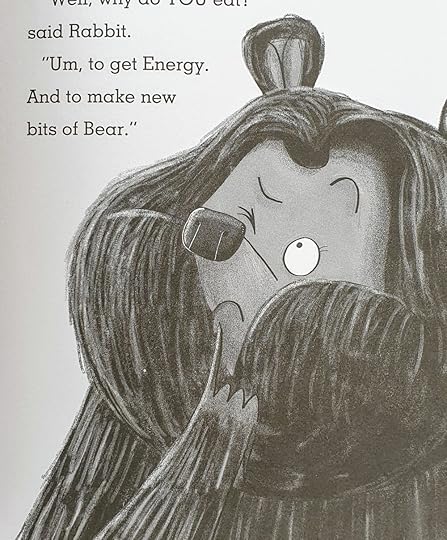
Detail from Rabbit & Bear: Rabbit’s Bad Habits by Julian Gough, ill. by Jim Field (Hodder 2016) | Illustration © Jim Field 2016
Rabbit’s Bad Habits is typical of kids’ books, in that it is about friendship - with the additional frisson of danger as a wolf is thrown into the mix. Rabbit is rescued by Bear, Wolf is defeated, and Rabbit and Bear become friends. Huzzah!
But that’s pretty much where the similarities end.
Because, unlike most children’s books, Rabbit’s Bad Habits has the feel, format (and language) of a chapter book for early readers - yet is fully illustrated throughout like a picture book. And you’ll find none of the insipid, frankly boring characters that often populate children’s books. Instead, we have some great characterisation, drawn out in the witty dialogue and excellent art.
And it really is funny.
Like Judith Kerr’s The Tiger Who Came to Tea, Gough created Rabbit’s Bad Habits as an antidote to reading ‘the most boring picture book on earth’ to his daughter: ‘There was no conflict; no drama; no STORY,’ he bemoans. ‘All the animals were polite, well-behaved, and perfect. They had nothing to learn, and nowhere to go. No problem to solve.’
(For the same reason, Mo Willems created his Elephant & Piggie characters.)
So with the help of his daughter, Gough started working on their own story, hoping to create a mash-up of Winnie-the-Pooh and David Attenborough - combining complicated, funny (and interesting) characters, with the weird, real-life facts of wildlife documentaries.
‘[N]o animal I know is nice, friendly and perfect. How boring would THAT be? Animals wee on the carpet sometimes, and sniff each other’s bottoms ALL the time, and chew the furniture. And that’s just our pet cat…
And wild animals… are even wilder than that! What is the point of having bears and rabbits in your story if they aren’t WILD, and doing the crazy, surprising, and often rather rude things real bears and rabbits do?
- Julian Gough (I wanted to mash up Winnie the Pooh and David Attenborough)
Rabbit has many bad habits.
Not only is he irascible and uppity (and a thief to boot), but the Law of Nature dictates behaviour that some, like Bear, might find rather uncouth.
After eating ‘lots and lots AND LOTS of the honey, and frozen salmon and delicious beetles’ eggs, that he’d stolen off Bear during the storm’, Rabbit ‘did a little poo and then ate it.’
Just look at Rabbit’s furtive expression!
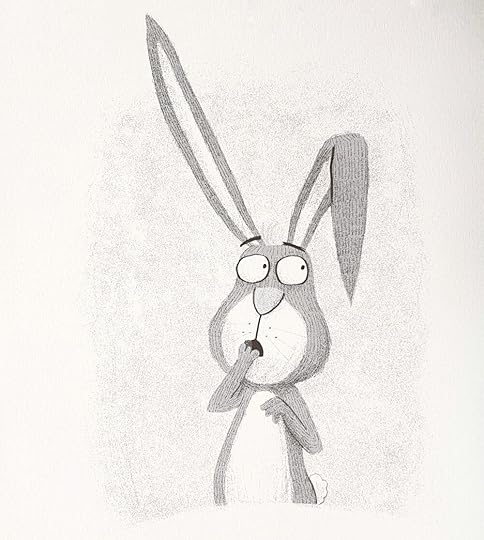
Detail from Rabbit & Bear: Rabbit’s Bad Habits by Julian Gough, ill. by Jim Field (Hodder 2016) | Illustration © Jim Field 2016
This rather embarrassing habit was the reason Rabbit never invited people over for tea.
The following page, where Bear pokes her head into Rabbit’s burrow (“I forgot to say thanks for the carrot,” said Bear’s voice right behind Rabbit), made me laugh out loud.
Poor Rabbit jumps out of his skin!
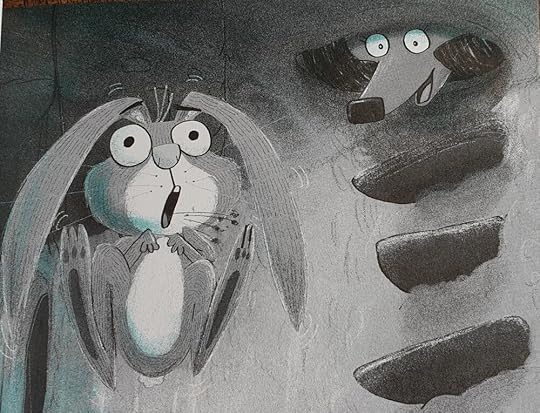
Detail from Rabbit & Bear: Rabbit’s Bad Habits by Julian Gough, ill. by Jim Field (Hodder 2016) | Illustration © Jim Field 2016
“I say, Rabbit, did you just eat your own poo?” said Bear, wondering if she’d seen right.
“Ah,” said Rabbit. “Yes. A little bit.”
“A little bit of YOUR OWN POO?” asked Bear, wondering if she’d heard right.
“Shush!” said Rabbit, glancing around. “Look, all rabbits do it. It’s perfectly normal.”
“For a rabbit, maybe,” said Bear.
Genius!
As a rule, I don’t like toilet humour. I think it’s unsophisticated and irritating. (Fortunately, my kids didn’t go around shouting, “Poo! Wee! Bum!” all the time. I know - it’s perfectly normal, plenty of kids do. But it’s still irritating.)
But Gough’s writing is not unsophisticated. It’s very clever - and funny! And as with all good stand up comedy, the humour is based on real-life observation.
As Rabbit points out (somewhat defensively) - “I’m sure bears do some things in the woods that they wouldn’t like to talk about.”
Now here comes that Attenborough influence. Caught in the act of doing his Private Business, Rabbit is left with no choice but to explain to Bear (with the aid of a diagram drawn in the snow) how the digestive system of rabbits works!

From Rabbit & Bear: Rabbit’s Bad Habits by Julian Gough, ill. by Jim Field (Hodder 2016) | Illustration © Jim Field 2016
[I] t’s really, really difficult to make a rabbit out of plants… Because when you’ve eaten the plants, and digested them in your tummy for hours, and pooed them…the job is only half done!”
“No energy?” said Bear.
“None!” said Rabbit.” The energy is still trapped in the poo! It’s sort of soft and black, like licorice… So you have to eat your own poo, …and digest it ALL OVER AGAIN to get the energy out.
“Really?” said Bear. For some reason she wasn’t hungry anymore.
This passage reminded me of the brilliant natural history book, Poo: A Natural History of the Unmentionable by scientist-author Nicola Davies and Neal Layton (Walker Books 2004):
- Nicola Davies Poo: A Natural History of the Unmentionable, ill. By Neal Layton (Walker Books 2004)
Rabbits, for example, simply can’t get all the nourishment they need from their food unless they digest it twice. And the simplest way to do that is to tuck into their own faeces. First, bunny eats fresh green leaves or grass, which passes through its digestive system and pops out as soft, dark pellets of poo. The rabbit eats these, still warm, straight from its bottom, and the food gets digested for a second time. After that, bunny has got all the nourishment it can from its meal…
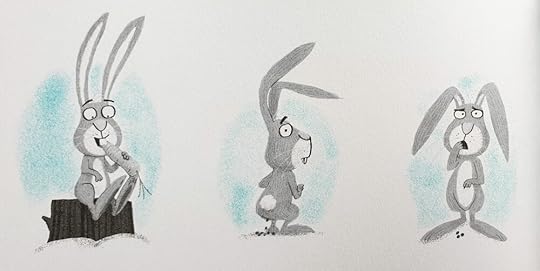
Detail from Rabbit & Bear: Rabbit’s Bad Habits by Julian Gough, ill. by Jim Field (Hodder 2016) | Illustration © Jim Field 2016
Rabbit’s Bad Habits is multi-faceted. At face value, it’s a straight-up story about friendship, with some solid scientific facts thrown in. But I think Gough understood that he was also presenting opportunities for more in-depth, philosophical discussions with your kid:
“From dawn to dusk, you’re eating and pooing,” said Rabbit gloomily. “And half the time you’re eating poo. It’s an awful life.”
No wonder Rabbit is so grumpy!
It also explains - without casting moral judgement - why, at the very start of the book, Rabbit steals Bear’s food: because it was full of energy. (And so much tastier than poo!)
Rabbit & Bear is anything but predictable. It is, as Neil Gaiman put it, ‘a breath of fresh air.’
And as Kirkius Review summarised so well: Young readers will come away with fresh insights into both poo and peacemaking.
Find the authors online:www.juliangough.comwww.jimfield.meGood to ReadA fun and factual book about poo
Nicola Davies Poo: A Natural History of the Unmentionable, ill. By Neal Layton (Walker Books 2004)
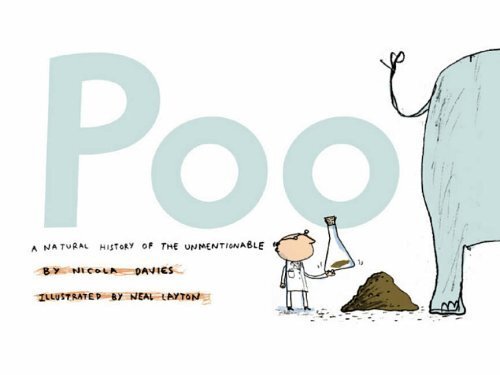
SourcesSorry! by Norbert Landa, ill. by Tim Warnes (Little Tiger Press 2009)Rabbit & Bear: Rabbit’s Bad Habits by Julian Gough, ill. by Jim Field (Hodder 2016) An Interview with Illustrator Jim Field (Silver Dolphin Books’ blog)Julian Gough: I wanted to mash up Winnie the Pooh and David Attenborough (The Guardian, 24 March, 2016) Rabbit’s Bad Habits review (Kirkus Books)
My Life in Books
For lovers of kid lit, this memoir - My Life in Books - is intended to give you the confidence and encouragement to share your own passion; to help you make lasting connections through kids’ books.
Originally posted at www.timwarnes.com ...more
- Tim Warnes's profile
- 30 followers



